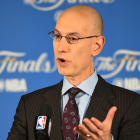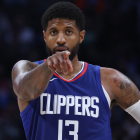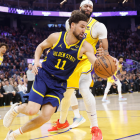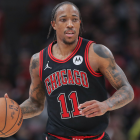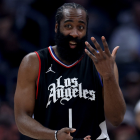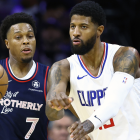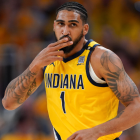The line in the sand for NBA owners came in 1997 when a 22-year-old prep-to-pro prodigy named Kevin Garnett signed a six-year, $126 million deal with the Minnesota Timberwolves.
On Friday, the first day of 2016 NBA free agency, four players agreed to deals that were a year shorter than that landmark contract for Garnett, but worth more money: Andre Drummond, Mike Conley, DeMar DeRozan and Bradley Beal. Conley's contract -- five years, $153 million to stay in Memphis -- is the most lucrative in NBA history.
Conley, 28, has never made an All-Star Game in his nine-year career. And his record score was a mere drop in the bucket of the $1.72 billion that was handed out in 27 contracts on Day 1 of free agency.
To those not well versed in the history and intricacies of the collective bargaining agreement, it's absurd. Once again the NBA has entered that uncomfortable realm where the general public believes that players are overpaid. #NBAMoney is a trending topic and regular people are dumbfounded.
Five years, $85 million for Evan Fournier? What about $50 million for Jordan Clarkson -- not to mention $52 million for Solomon Hill, who started three games last season?
How did this happen? It's a long, complicated story, so let's go back to the beginning.
Birth of the max contract
Garnett's deal, coming on the heels of Juwan Howard and Alonzo Mourning breaking the $100 million barrier, was so offensive to the owners that they locked the players out on July 1, 1998. It was a long, bitter, ugly fight. When it was finally over, the max contract was born.
Shaken that a player with only two years experience could cash in like Garnett did, the owners insisted on a cap for veteran contracts. No more nine-figure deals for players who'd yet to make the playoffs or lead the league in anything. No more 10-year, $68 million deals for rookies, as Glenn "Big Dog" Robinson had snatched up in 1994 as the No. 1 overall pick.
In addition to capping what players could make on the top end and creating the mid-level exception in '98, the owners and union had agreed in '95 to create the rookie scale, which increased cost certainty and control for teams. (Garnett's deal had been grandfathered in.) Instead of rookies or second-year players getting what the market would bear, the salaries of first-round picks were calibrated based on where they were picked. Such contracts were pre-set as two-year deals, with team options for the third and fourth year before the player entered free agency -- first, as a restricted free agent (if his team wanted to retain him) and then unrestricted.
As for veterans, the most they could make would be capped at a percentage of the salary cap based on years of experience. In its current iteration, the max is capped at 25 percent of the cap for players with 0-6 years of service; 30 percent for 7-9; and 35 percent for those with 10-plus years. Of course, there are a slew of exceptions -- from Bird rights to the Derrick Rose rule -- but the basic intent is the same. The owners decided in the late 1990s that they needed control and cost certainty at both ends -- for rookies and star players with experience.
Middle class thrives
So with the player compensation pool fueled by ever-increasing revenue and salary bottlenecks at both ends, it should be no surprise that the players in the middle have been the ones who've thrived the most. The so-called "middle class" -- an unfortunate term that agents and the union have long used that is insulting to the actual middle class -- has seen the money flow to them. This has happened in the form of the mid-level exception (a tool that teams can use in various forms to exceed the cap to add a free agent) and in less-than-star players getting the max.
It's how a backup center (Jerome James) and third-string point guard (Cory Joseph) have scored $30 million deals over the years. It's how Hassan Whiteside and Chandler Parsons, with nary an All-Star appearance between them, both struck deals Friday at just a shade under $100 million -- for four years.
Timofey Mozgov, who made six postseason baskets and barely played during the Cavaliers' run to a championship, landed a four-year, $64 million deal with the Lakers. Matthew Dellavedova -- the Rudy Ruettiger of the NBA -- agreed on a four-year, $38 million offer sheet with the Bucks. Since Dellavedova is a restricted free agent, the Cavs had the opportunity to match the offer.
In terms of return on investment, better to put an actual match to it.
"The union has made the decision that it's better for LeBron James to give up $20 million or $30 million in salary so that Jodie Meeks can make $6.7 million," longtime agent David Falk told me last summer on this topic. "... They try to make rules to homogenize everybody because there are many more Matthew Dellavedovas than LeBrons, so the rules are skewed toward those guys. You're grossly overpaying the people that aren't as valuable because you've created this artificial limitation."
One of Falk's clients, by the way, Jeff Green, scored a one-year, $15 million deal with Orlando on Friday. That's the new version of reasonable.
The problem Falk describes has been going on for years, and has partially been a function of the league's biggest stars being ambivalent to the labor process until it's too late -- as well as being outnumbered by the rank and file. And the truth is, with what, about 10 true superstars in the league, the union's job is to look out for the other 440. Without them, there would be no league for James, Kevin Durant and Stephen Curry to play in.
But it's also true that with no maximum salary restriction, James would probably make twice what he's currently eligible for when he re-signs with the Cavs -- $60 million a year instead of $30 million. Ditto for Curry (who will make only $12 million next season) when he becomes an unrestricted free agent as early as 2017.
In recent years, stars like James, Curry, Chris Paul and Carmelo Anthony have become more involved; all currently serve on the union's executive committee, and Paul is the union president. And while the league and union are engaged in serious talks to revise the CBA ahead of the Dec. 15 deadline for either side to opt out, the system governing salaries is what it is for now.
Unintended consequences
The phenomenon of middle-of-the-road players getting maxed out once they're free of the rookie wage restrictions has only been worsened by something that commissioner Adam Silver has called "a good problem to have" -- the massive increase in the salary cap due to unanticipated tripling of the NBA's broadcast rights deals.
The cap is calculated on a percentage of revenue, which has exploded by $1 billion in the last three years alone. It's essentially a 50-50 split among players and owners. This coming season marks the first year of the league's nine-year, $24 billion TV deal with ABC/ESPN and Turner. Silver, his predecessor David Stern and the former executive director of the players' association, Billy Hunter, did not anticipate such a massive increase -- from an average of $930 million a year in TV revenue to $2.67 billion.
That, coupled with the union's new director, Michelle Roberts, rejecting the league's proposal to smooth the money into the system gradually, has resulted in a spike in the cap from $70 million last season to $94 million this season and a projected $110 million next season. With the two-year spike distributing money disproportionately among the players based on the arbitrary timing of free agency -- and making the search for a match between pay and performance even more elusive -- Roberts may rue the day she rejected the league's smoothing proposal.
With poor planning and no smoothing, the marketplace was suddenly flooded with $1 billion in cap room this summer, with 21 of the 30 teams having room to offer a max contract. Add a provision negotiated by Hunter requiring teams to spend at least 90 percent of the cap -- creating a payroll floor of $85 million -- and you have an unprecedented spending spree.
"The mechanism in which the cap levels and tax levels are set, that's where the disruption is coming this summer," Silver said before the season. "Arguably a good problem to have. But an unanticipated rise in the cap, as we've talked about many times, [will result in] a free agency market that will be very difficult to predict."

Until now, Silver has taken a wait-and-see approach before predicting doom and gloom for such a flood of money into the system.
"Let's see what actually happens this summer and let's see just how disruptive it is," he said.
Well, now we're beginning to see.
The problem is two-fold: a system that was created to award the vast middle ground of players at the expense of those who truly deserve the most money, and a failure by both sides to anticipate the extent of the TV spike. With no mechanism in the CBA to address it, the dollars are flowing disproportionately to players who happen to be free agents this summer and next. For example, for Tristan Thompson to get the security of a five-year deal, he had to re-sign with the Cavs last summer based on old cap parameters: five years, $82 million. Hitting free agency a year before the cap spike probably cost Thompson about $40 million.
"It's something, without getting into specifics, that we will be discussing internally and of course discussing with the players' association," Silver said. "And the only changes we can ultimately make are by agreement with the players."
In the current CBA, the league did shorten contracts and install such remedies as the stretch provision, both of which give teams more flexibility to correct free-agent mistakes. But the negotiating dance between owners and players always has unintended consequences. This time around the ripple effects of the spike could divide locker rooms -- where disproportionate salaries could bruise egos -- and imperil Silver's efforts to create a competitively balanced system.
The Golden State Warriors, who won 73 games last season and already have three All-Stars and the two-time reigning MVP, actually have a legitimate shot at signing the top free agent on the market, Kevin Durant. Such an outcome could represent the symbolic death knell for small- and mid-sized markets in their efforts to persuade fans they can actually compete with the glamour markets "if well managed," as Silver so frequently put it during the 2011 lockout.
Interestingly, during his All-Star address in February, Silver significantly walked back his rhetoric on how competitively balanced the NBA can be.
"We're never going to have NFL-style parity in this league," he said.
That's a big problem. But as the money continues to flow in the form of massive contracts that the average fan can't understand, there's one unintended consequence that the NBA can't afford. At a time when the league is soaring both financially and in popularity, the last thing it wants is to turn back the clock to the '90s -- when the perception of NBA players was that too many of them were making too much money that they didn't deserve based on performance.
Nicolas Batum is a nice player, but what if his five-year, $120 million contract makes fans resent him? What if he becomes the next Rashard Lewis? What if Conley becomes the next Joe Johnson? How is a 28-year-old guard who's never been an All-Star supposed to live up to the richest contract in league history?
The only good news for Conley, other than the spike in his bank account, is that he won't be the league's highest player for long.
At this rate, maybe not even for a full day.








